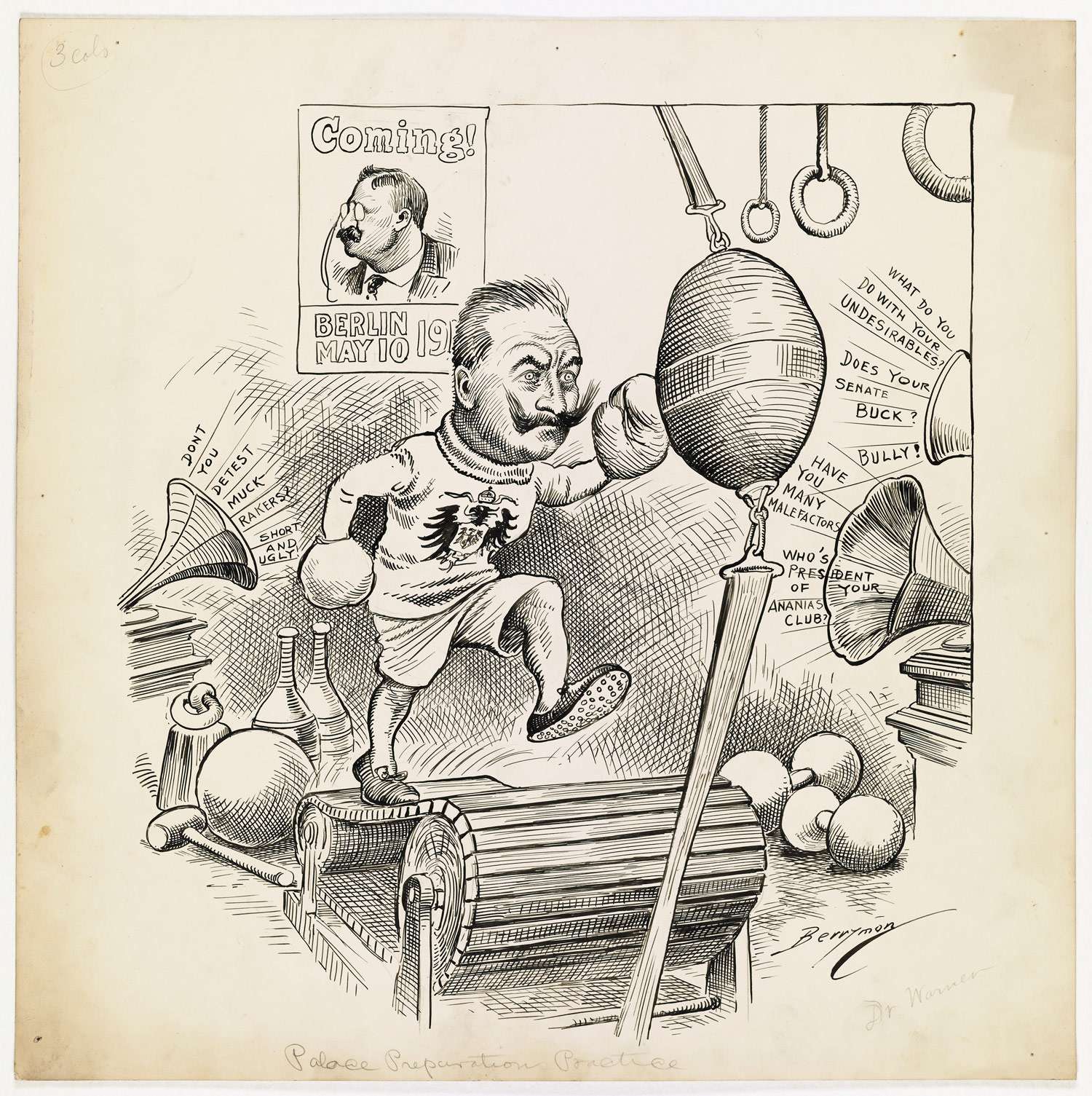Palace Preparation Practice
5/1/1910
Add to Favorites:
Add all page(s) of this document to activity:

In this cartoon, German Kaiser Wilhelm II runs on a treadmill as three phonographs play the words of President Theodore Roosevelt. A month earlier, The Washington Post had published a mock conversation between the Kaiser and Roosevelt that ended with Roosevelt saying “There are some short and ugly words in German.” “Short and ugly” appear as words coming out of a phonograph in the cartoon along with familiar phrases associated with Roosevelt. The cartoonist implies that the Kaiser was copying the fitness regime of the President, who had employed a White House boxing coach.
A poster in the background announces Roosevelt’s upcoming visit to Berlin. Kaiser Wilhelm had invited the former President to visit him at the palace, an honor never before given to a foreign guest. The two leaders had much in common. Roosevelt’s leadership of a U.S. naval build-up was mirrored by the Kaiser’s strengthening of the German Navy.
This cartoon appeared at a time when many were concerned that the Kaiser was leading Germany toward war. While Berryman shows the Kaiser’s desire to imitate Roosevelt’s macho style, it does not explicitly emphasize German military ambitions.
This cartoon was drawn by Clifford Berryman, one of Washington, DC's best-known cartoonists in the early to mid-1900s. Berryman drew for the Washington Post and Evening Star newspapers. His cartoons touched on a variety of subjects including politics, elections, and both World Wars.
This cartoon is featured in America and the World: Foreign Affairs in Political Cartoons, 1898–1940, a free PDF book from the Center for Legislative Archives at the National Archives.
A poster in the background announces Roosevelt’s upcoming visit to Berlin. Kaiser Wilhelm had invited the former President to visit him at the palace, an honor never before given to a foreign guest. The two leaders had much in common. Roosevelt’s leadership of a U.S. naval build-up was mirrored by the Kaiser’s strengthening of the German Navy.
This cartoon appeared at a time when many were concerned that the Kaiser was leading Germany toward war. While Berryman shows the Kaiser’s desire to imitate Roosevelt’s macho style, it does not explicitly emphasize German military ambitions.
This cartoon was drawn by Clifford Berryman, one of Washington, DC's best-known cartoonists in the early to mid-1900s. Berryman drew for the Washington Post and Evening Star newspapers. His cartoons touched on a variety of subjects including politics, elections, and both World Wars.
This cartoon is featured in America and the World: Foreign Affairs in Political Cartoons, 1898–1940, a free PDF book from the Center for Legislative Archives at the National Archives.
This primary source comes from the Records of the U.S. Senate .
National Archives Identifier: 6010841
Full Citation: Cartoon G-033; Palace Preparation Practice; 5/1/1910; Berryman Political Cartoon Collection, 1896-1949; Records of the U.S. Senate , Record Group 46 ; National Archives Building, Washington DC, 20408. [Online Version, https://docsteach.org/documents/document/palace-preparation-practice, April 19, 2024]Rights: Public Domain, Free of Known Copyright Restrictions. Learn more on our privacy and legal page.



